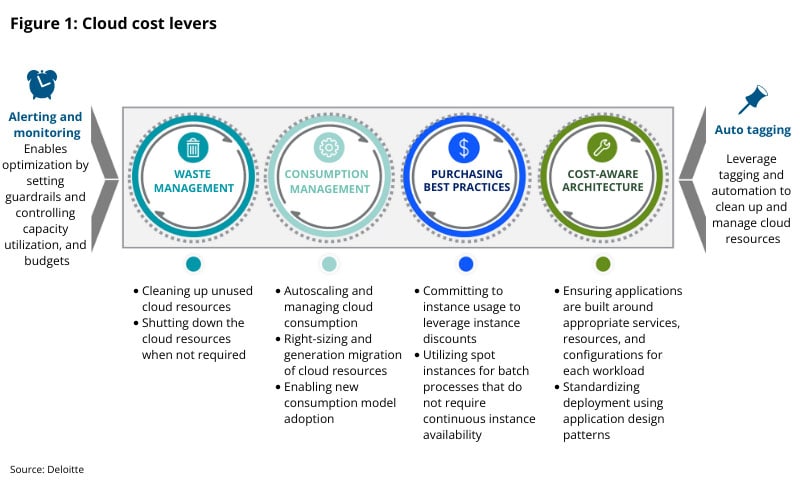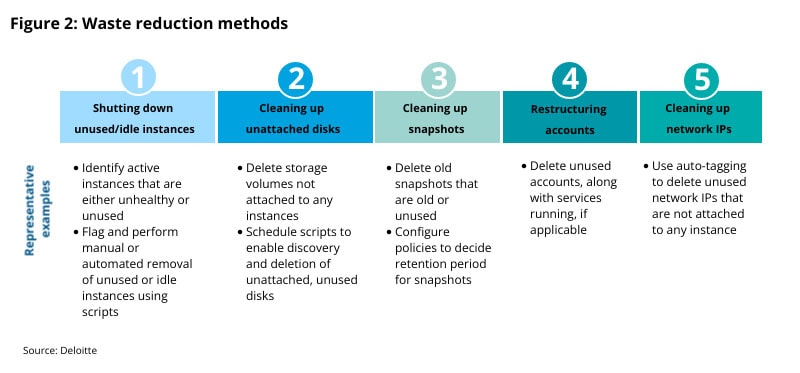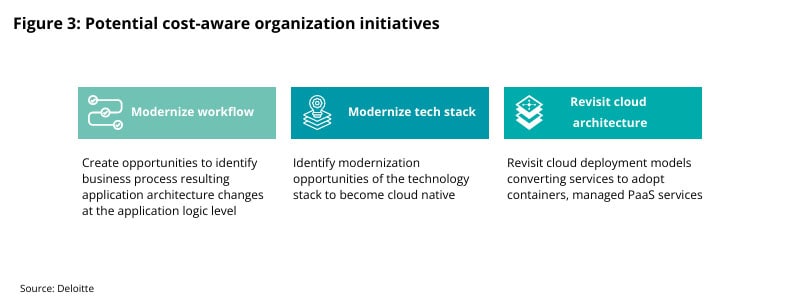Four Key Optimization Levers for Cloud | Deloitte US has been saved
A blog post by Nikhil Roychowdhury, principal, Deloitte Consulting LLP; Nik Jethi, senior manager, Deloitte Consulting LLP; Farhan Akram, manager, Deloitte Consulting LLP; Rishabh Kochhar, senior consultant, Deloitte Consulting LLP.
In the previous post in this three-part series, we discussed how businesses can optimize cloud costs using four crucial levers: waste management, consumption management, purchasing leading practices, and cost aware architecture. Further, each of these levers is supported by two enablers: alerting and monitoring, and automated tagging. In this post, we explore each of these levers in-depth.
While all the cost optimization levers work in tandem with each other, there are clear benefits that can be achieved with each of these levers, as shown in figure 1.
Cost optimization levers in depth
Let’s dive deeper into each of these levers and enablers to explore how they can help businesses optimize their cloud spend.
Waste management
Waste management is a critical FinOps lever that helps minimize wasteful expenses and refers to the management of resources that generate waste in terms of usage and cost. For example, an instance and its underlying storage no longer in use are potential waste, leading to avoidable expenses. Waste management helps to navigate the challenges posed by cloud environments where resources are being continually provisioned, scaled, and de-provisioned. Significant cloud spend is also wasted via instances that are over-provisioned and due to lack of optimized networks across the three major public cloud providers every year.
Common ways to reduce cloud waste are included in figure 2.
Consumption management
Consumption management refers to the management of resources that are currently in use but are over-provisioned. For example, an instance in use with low usage metrics might be an over-provisioned resource. With the ease that cloud resources can be provisioned spur of the moment, it becomes imperative to manage consumption patterns to avoid excess costs. Some common consumption management practices are:
- Replacing expensive storage: Evaluate storage requirements against parameters such as ideal storage type, redundancy options, and access frequency to select the optimal storage and prevent overspending.
- Migrating to lower-cost instance types or regions: Switch costly instance series to cheaper, older instance series where possible, and select regions with lower costs.
- Rightsizing instances: Analyze resource consumption of virtual machines to determine the optimal instance size, and use cost-monitoring tools.
- Leveraging a reserved and spot instance strategy: Analyze current instance usage and future demand levels to identify a reserved instance strategy, and utilize spot instances for batch processes that do not require continuous instance availability.
- Automating optimization: Use automation to create alerts that trigger automated actions to resolve inefficiencies, and use autoscaling systems to utilize resources effectively.
- Tagging analysis: Apply organization-wide tagging policies for better tracking and visibility into account-level spending patterns, and allocate costs to appropriate cost centers and business units.
- Reducing data transfer costs: Analyze data transfer across one-way and two-way traffic and between instances on different availability zones, virtual private clouds, or regions. Identify savings opportunities by placing workloads where data transfer costs can be optimized.
Purchasing leading practices
Purchasing leading practices refer to tactics to utilize all available procurement levers to manage the complexities of cloud provider pricing models, optimize rates, and drive unit cost efficiency. Over long periods, businesses can significantly reduce their cloud spend by leveraging purchasing leading practices while provisioning cloud resources. Following these leading practices can result in the following benefits:
- Direct cost savings by:
- Helping achieve the exact portfolio of resources at a discounted price
- Creating opportunities to continuously increase the resource-to-dollar ratio
- Gaining operational efficiency by:
- Creating customized instance configurations that best meet requirements
- Scaling up or down by integrating reserved resources with on‑demand resources
- Providing flexibility to modify, convert, exchange, resell and cancel reserved resource
Implementing cloud purchasing leading practices is not a one-time activity, but a gradual process that evolves with time. Businesses can take three key steps to help ensure that they can purchase cloud resources on favorable terms
1. Data gathering and filtering
- Ensure that all instances are properly “tagged” to identify consumption trends
- Filter out instances with low utilization (e.g., instances with uptime of less than 65%) to check if convertible RIs or spot instances can replace them.
2. Data aggregation
- Aggregate hourly data by various attributes, such as instance type, environment, application type, operating system, tenancy, and availability zone.
- Review the most expensive groups to identify right-sizing opportunities.
3. Scenario identification
- Consider savings plans and spot instances along with convertible reserved instances to achieve maximum discounts, along with automating the purchasing activity.
- Identify regions/zones to buy resources from without compromising on latency.
Cost-aware architecture
Traditional cost optimization efforts focus on optimizing applications already running on public cloud infrastructure through the IaaS-focused levers—consumption management, waste management, and purchasing tactics. However, very few organizations have evaluated the potential of addressing the application architecture and revisiting architectural decisions to drive even higher levels of optimization.
A cost-aware architecture can help optimize costs by ensuring applications are built around appropriate services, resources, and configurations for each workload. Application design patterns are adopted by business units to standardize deployment and manage workloads. Additionally, these patterns can help set preventive and detective controls (or guardrails) to enable future cost tracking.
Cost-aware architectures focus on three main goals:
- Be better, faster, and more cost effective. Apply an application lens to cost optimization by looking under the hood of applications and evaluating all aspects of the architecture for greater effectiveness, efficiency, and agility.
- Drive cost-aware culture. Drill down into the application layer to understand cloud consumption that product development teams understand, and re-enforce best practices at the organization level.
- Enable cloud-native capabilities. Set the foundational structure to effectively respond to the increasing velocity, complexity, and volume of business needs.
Key measures in achieving cost-aware architecture are listed below:
- Address spend for large monolithic applications where significant cloud consumption occurs and right-size accordingly.
- Develop architectural recommendations to improve the cost profile for your applications.
- Evaluate architectural decisions with a cost lens (individually or as a group) to determine the ROI of executing application changes.
- Build a cost road map alongside a technical road map to provide a clear picture of benefits realization.
- Standardize architecture patterns for better governance across applications.
- Leverage cloud-native capabilities, such as containers and serverless technologies, to manage costs.
- Build processes aimed at eliminating technical debt.
- Drive cultural norms toward enterprise-wide cost awareness through change management efforts.
Enablers for cloud cost optimization
While each of the above levers is crucial to optimize cloud costs, they are collectively driven by two enablers: auto-tagging, and alerting and monitoring.
Auto-tagging:
Auto-tagging refers to mapping cloud resources and services to organizational and operational metadata by leveraging scripts and automations. This can help eliminate the need to manually tag resources, enabling more efficient control of cloud resources. Effective auto-tagging can help enterprises enhance their operational efficiency, improve governance, and add conditional tags based on business context.
Alerting and monitoring:
Alerting and monitoring is using alerts driven by capacity, utilization, or budget thresholds for effective control of cloud resources and services. This enables holistic and sustainable cloud financial management. Alerting and monitoring helps to optimize current cloud costs and sets guardrails for future deployments and cost tracking.
Alerting and monitoring help businesses by enabling real-time usage and cost monitoring, improving real-time data analysis, reducing incident response time, driving operational effectiveness, enhancing spend visibility, and helping right-size resources.
Wrapping it up
To recap, cloud cost optimization involves a combination of improving visibility and accountability of cloud spend, continuous efforts to reduce known and unattributed costs, and enhancing planning and forecasting. For effective cloud cost optimization, businesses should start with assessing their current-state maturity levels, cloud costs, governance mechanisms, FinOps capabilities, and operating models.
Depending on their maturity levels, businesses should identify gaps against the target state they want to achieve. Next, enterprises should align their cloud cost optimization efforts across four key levers: waste management, consumption management, purchasing best practices, and cost-aware architecture.
Each of these levers, supported with enablers such as alerting and monitoring and auto-tagging, help drive operational and financial improvements, with direct impacts on the bottom line and productivity. These efforts should be aided with cost optimization tools provided by cloud service providers and third-party market leaders.
To learn more:
Read the first blog in this series, Optimizing the value of cloud: A practical guide to getting started.
Read the third blog in this series, Optimizing the value of cloud: The impact of optimization.
Get in touch

Nikhil Roychowdhury
Nikhil is a principal with Deloitte Consulting’s Financial Services practice. With more than 20 years of experience as a trusted technology advisor to large global banks and insurance providers, Nikhil has designed and executed multiple large-scale, global transformation programs to enable new business capabilities and drive innovation. Nikhil specializes in Cloud Strategy, guiding his clients through all phases of their technology modernization journeys, from defining an overall vision and strategy to designing and implementing new operating models aligned to modern technology delivery practices. An engineer at heart, Nikhil leads platform and application teams to deliver scalable cloud platforms and enable new use cases made possible by Cloud. Nikhil leads Deloitte’s Cloud FinOps offering for the US market, driving go-to-market strategy, establishing partnerships with leading ecosystem partners, and delivering engagements to help his clients measure the value from their cloud investments.




